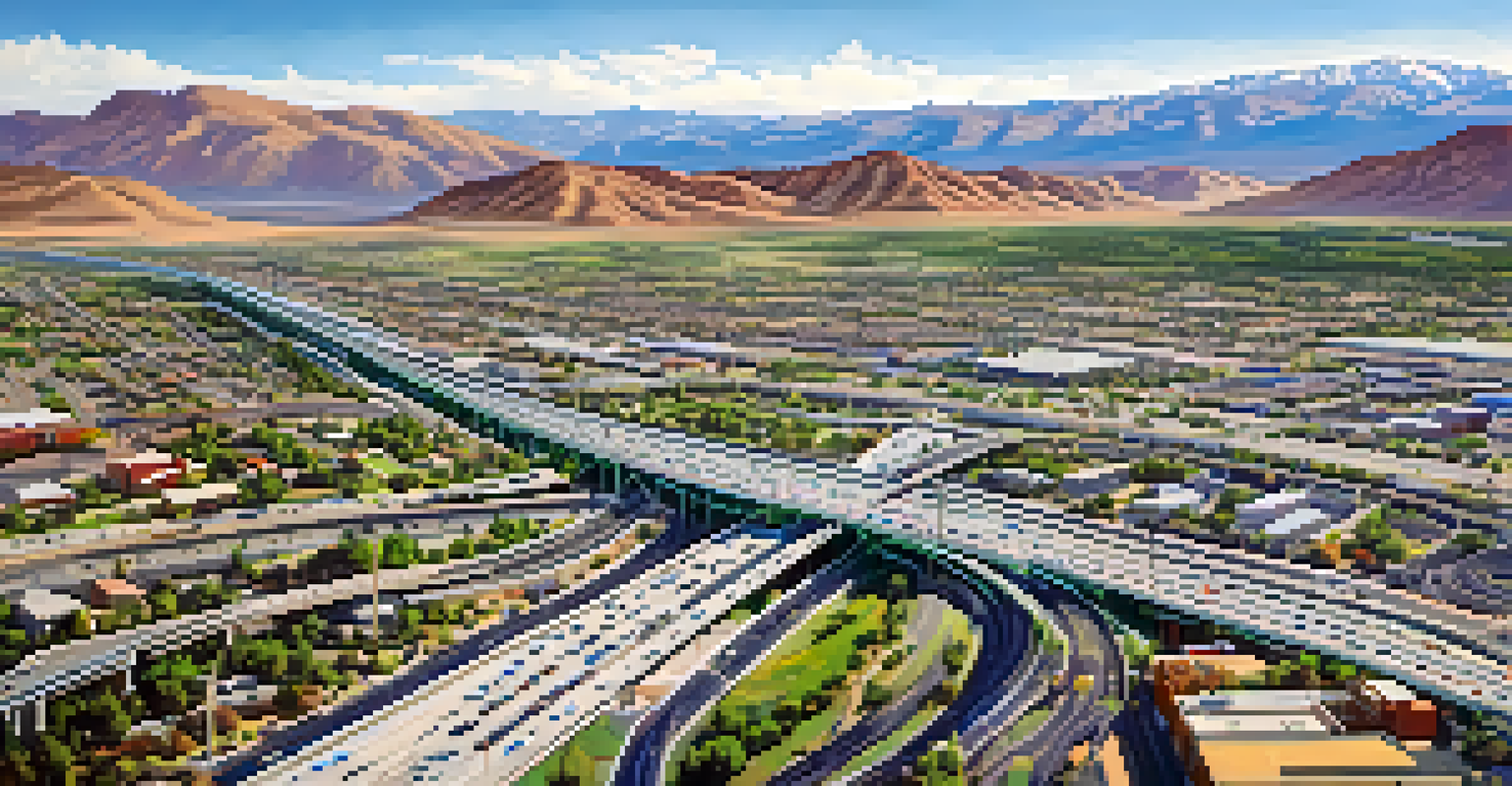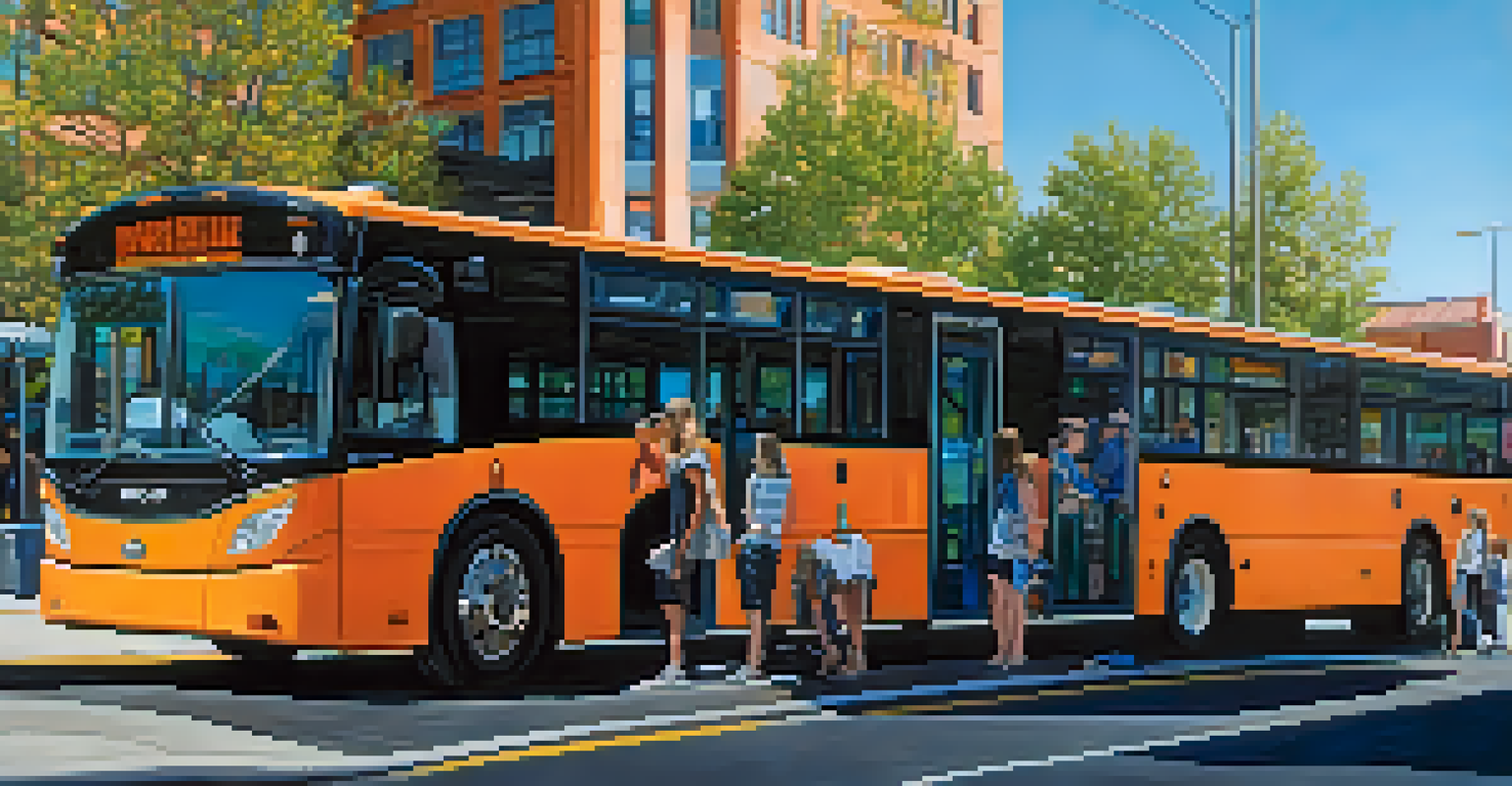Reno's Economic Growth Fueled by Efficient Transport Systems

The Backbone of Reno's Growth: Efficient Transport Systems
Reno's economy has seen a remarkable transformation over recent years, largely due to the development of efficient transport systems. These systems serve as the backbone of the city’s growth, enhancing connectivity and accessibility. When businesses can move goods and services swiftly, they can operate more effectively and reach a wider customer base.
Transportation is the backbone of a city's economy; it connects people to jobs and goods to markets.
Moreover, improved transport infrastructure attracts new businesses to the area, creating a ripple effect of job opportunities and economic vitality. For instance, the expansion of highways and public transportation options has made it easier for companies to set up shop in Reno. As logistics become seamless, the city positions itself as a competitive player in the regional economy.
In essence, Reno's transport systems not only facilitate the movement of people and products but also fuel the overall economic engine. This interconnectedness is vital for sustainable growth, making Reno an attractive destination for both entrepreneurs and skilled workers.
Public Transport: A Catalyst for Community Development
Public transport in Reno has evolved significantly, functioning as a catalyst for community development. With increased bus routes and the introduction of light rail, residents now have greater access to employment centers, schools, and recreational areas. This accessibility fosters a sense of community and encourages local business patronage.

For example, neighborhoods that were once considered isolated are now thriving due to the availability of reliable public transport. Families can easily navigate the city without the burden of owning multiple vehicles, which also leads to reduced traffic congestion. In turn, this enhances the quality of life for residents and attracts newcomers looking for a vibrant, connected community.
Transport Fuels Reno's Economy
Efficient transport systems enhance connectivity, attract businesses, and create job opportunities, driving economic growth in Reno.
Ultimately, by investing in public transport, Reno is not just improving logistics; it’s cultivating a more inclusive environment where everyone has a chance to contribute to and benefit from the local economy.
The Role of Freight Transportation in Economic Expansion
Freight transportation plays a crucial role in Reno's economic expansion, especially given the city's strategic location. Being situated near major highways and railroads allows for efficient movement of goods, making it a logistics hub for businesses. This has attracted numerous distribution centers and warehouses that contribute significantly to local employment.
A well-developed transportation system is crucial for community development and enhances the quality of life for residents.
Additionally, companies that rely on timely deliveries find Reno to be an optimal location. With access to regional markets and the West Coast, businesses can minimize shipping times and costs, enhancing their competitiveness. This accessibility not only boosts individual company growth but also stimulates the entire regional economy.
As freight transportation continues to develop, Reno's reputation as a logistics powerhouse solidifies, creating an environment ripe for further economic opportunities. This synergy between efficient transport and economic growth is a testament to the city's forward-thinking approach.
Connecting Reno: The Impact of Major Highways and Roads
Reno's extensive network of highways and roads is another key factor driving economic growth. Major routes such as Interstate 80 and U.S. Route 395 facilitate smooth travel for both residents and businesses alike. These highways connect Reno to larger markets, making it a strategic point for trade and commerce.
The ease of access provided by these transport routes has attracted a variety of industries, from manufacturing to retail. As companies recognize the logistical benefits of being in Reno, they are more likely to invest in the area, creating jobs and promoting economic diversity. This influx of businesses leads to a thriving economy that benefits all residents.
Public Transport Boosts Community
Improved public transport fosters community development by increasing access to jobs and services while reducing traffic congestion.
In conclusion, the investment in and maintenance of Reno's highway systems is instrumental in shaping the city’s economic landscape. With continued enhancements, these transport arteries will support further growth and development in the years to come.
The Future of Transportation in Reno: Innovations and Trends
The future of transportation in Reno is bright, with numerous innovations and trends on the horizon. As technology advances, Reno is exploring smart transportation solutions that enhance efficiency and reduce emissions. Initiatives such as electric buses and ride-sharing platforms are becoming more prevalent, making transport more sustainable.
Moreover, the integration of technology in traffic management systems promises to ease congestion and improve travel times. For instance, adaptive traffic signals can adjust based on real-time traffic conditions, providing a smoother experience for drivers and public transport users alike. These innovations not only improve the daily commute but also contribute to a more environmentally friendly city.
As Reno continues to embrace these transportation trends, the city is positioning itself as a leader in sustainable urban development. This forward-thinking approach will not only boost the local economy but also enhance the quality of life for its residents.
Tourism and Transport: A Vital Connection for Reno
Tourism is a significant contributor to Reno's economy, and efficient transport systems enhance this sector remarkably. The ease of access to attractions like Lake Tahoe and local casinos draws visitors from various regions. With well-connected transport options, tourists can explore the city and its surroundings without hassle, making their experience more enjoyable.
Additionally, improved transport infrastructure fosters partnerships between local businesses and tourism operators. Hotels, restaurants, and entertainment venues can work together to create packages that appeal to visitors, driving further economic activity. This interconnectedness between transport and tourism creates a vibrant atmosphere that benefits everyone involved.
Tourism Thrives with Better Transport
Efficient transport systems enhance tourism by making it easier for visitors to explore Reno and its attractions, boosting the local economy.
Ultimately, by prioritizing transport systems that support tourism, Reno is ensuring that it remains an attractive destination for travelers. This not only boosts the local economy but also enriches the cultural fabric of the city.
Community Engagement: The Key to Successful Transport Initiatives
Community engagement is essential for the success of transport initiatives in Reno. When residents are involved in the planning process, their needs and concerns can be addressed effectively. This participatory approach fosters a sense of ownership and pride in the community, leading to better outcomes for transport projects.
For example, public forums and surveys allow residents to voice their opinions on proposed changes to transport systems. This feedback can guide decision-makers in creating solutions that truly benefit the community. As a result, transport initiatives become more aligned with the residents' vision for their city.

Engaging the community not only helps in planning but also in promoting the use of efficient transport systems. When people feel connected to their transport network, they are more likely to utilize it, creating a positive feedback loop that enhances both the economy and community cohesion.